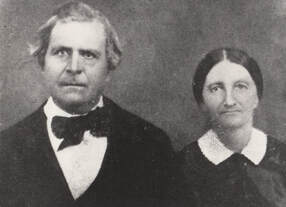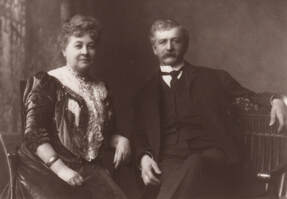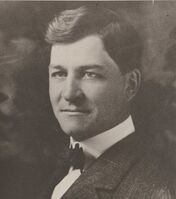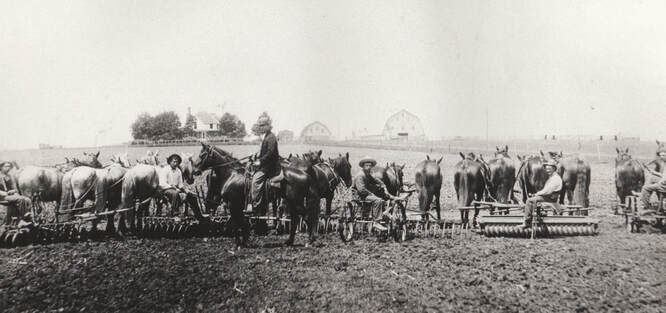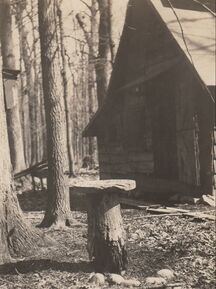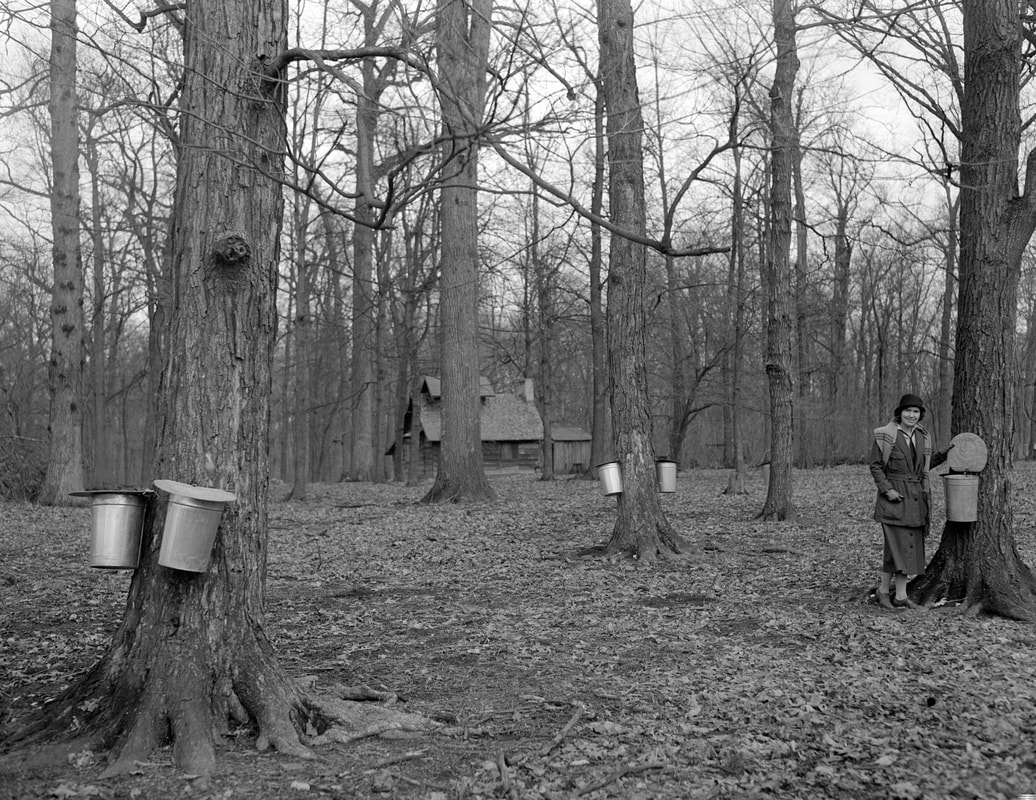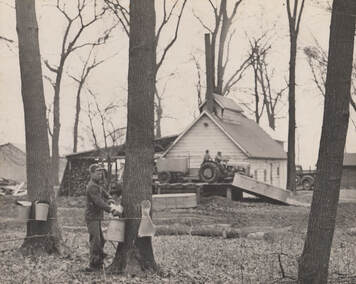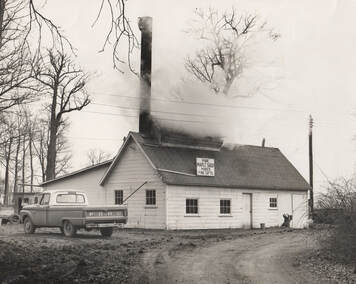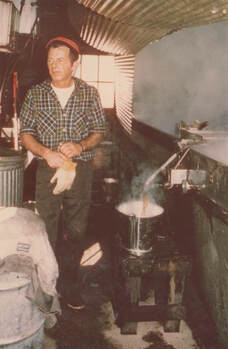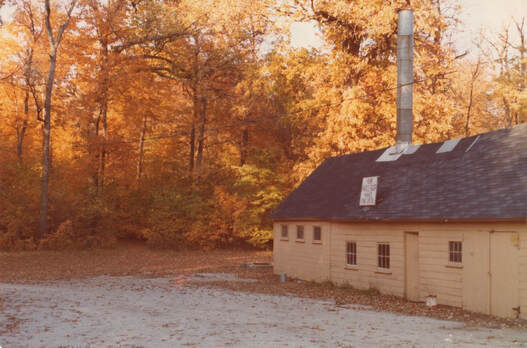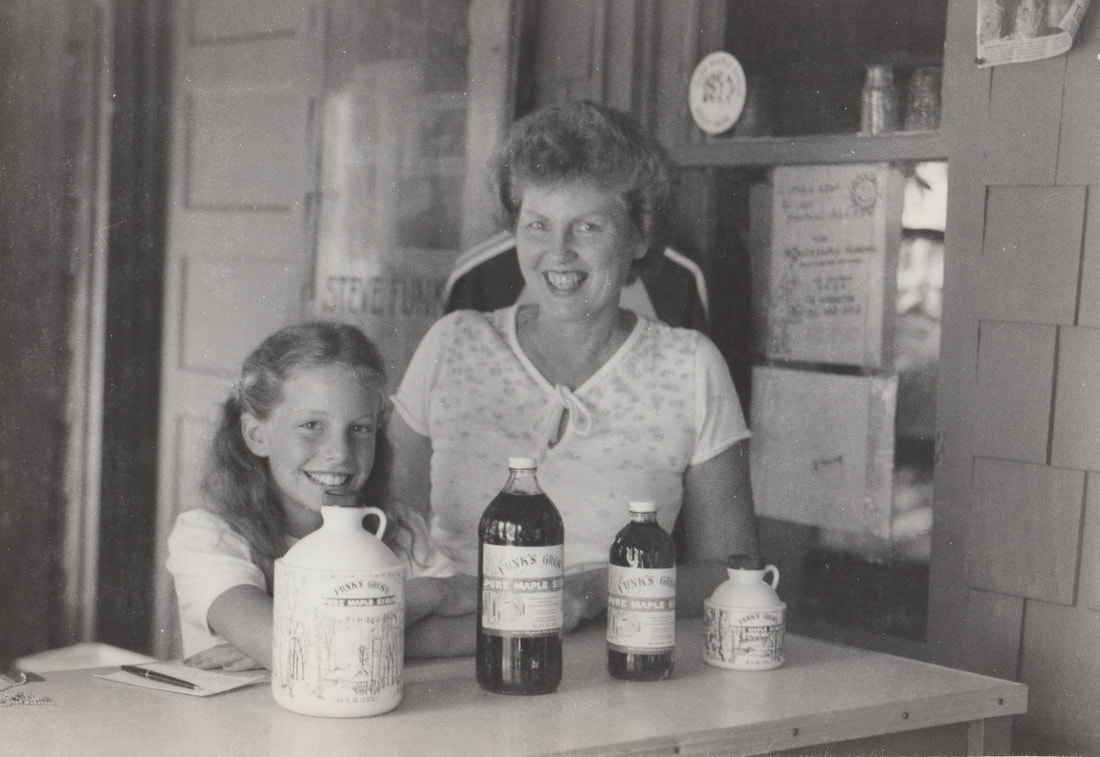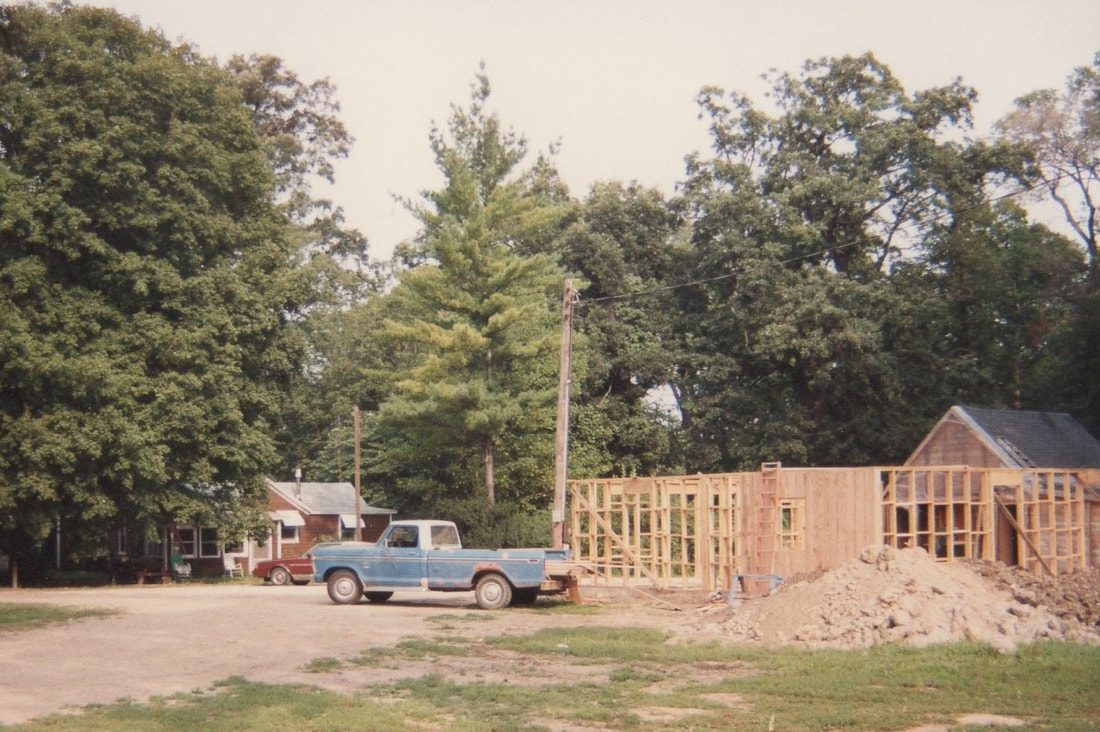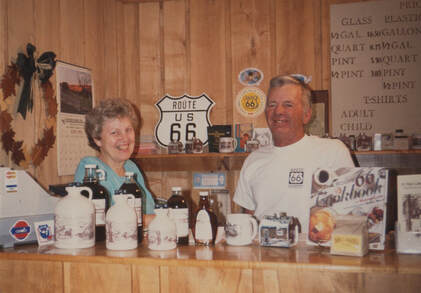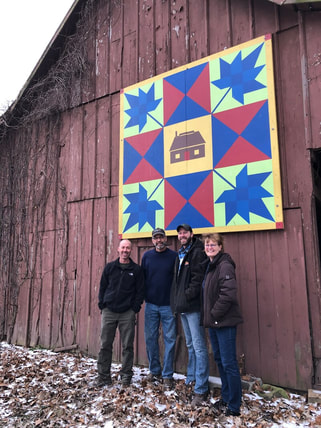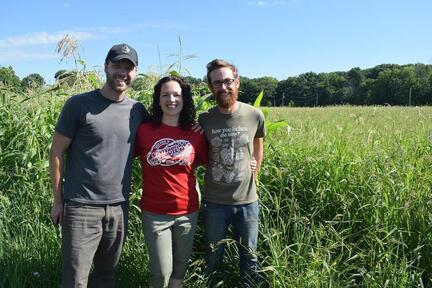The First Maple Sirup Producers
There is a long-standing family tradition of sirup making among the Funks of Funks Grove. However, the sweet benefits of the maple trees that grow in this native timber were likely enjoyed long before the Funk family settled here. History has it that Native Americans were the first maple sirup producers. They used maple sugar to season their corn and other vegetables and poured maple sirup over their fish and meat. Following is one of the many legends of how maple sirup was first discovered.
One night upon returning from hunting, an Iroquois chief name Woksis plunged his hatchet into the side of a tree for safe keeping overnight. In the morning, he removed his hatchet and went out to hunt. There happened to be a bowl directly underneath of the gash left by Woksis’ hatchet, and sap began to flow in the bowl. Woksis’ wife later noticed that this bowl was full of liquid and, mistaking it for water, used it to cook a venison stew. As the stew cooked, water evaporated from the sap, leaving a thick, sweet substance in the stew. Both Woksis and his wife were pleasantly surprised by the sweet-tasting stew, and thus it was discovered how maple sirup could be made from sap.
One night upon returning from hunting, an Iroquois chief name Woksis plunged his hatchet into the side of a tree for safe keeping overnight. In the morning, he removed his hatchet and went out to hunt. There happened to be a bowl directly underneath of the gash left by Woksis’ hatchet, and sap began to flow in the bowl. Woksis’ wife later noticed that this bowl was full of liquid and, mistaking it for water, used it to cook a venison stew. As the stew cooked, water evaporated from the sap, leaving a thick, sweet substance in the stew. Both Woksis and his wife were pleasantly surprised by the sweet-tasting stew, and thus it was discovered how maple sirup could be made from sap.
Early Years of Sirup Production in Funks Grove
|
Isaac Funk, the pioneer founder of what would later become known as Funks Grove, chose his location well in 1824—good water supply, fertile soil, and timber for shelter and heat. Isaac raised livestock and drove it to market on foot and later served in the Illinois Senate, where he was a friend and supporter of Abraham Lincoln. While he was away, his sons, led by the eldest, George Washington Funk (whom they dubbed “The General”), took care of the farm. Isaac and his sons also made maple sirup and sugar—cooking the sap in kettles over a fire—for personal use since it was the only readily available source of sweetener.
Around the year 1860, Isaac’s youngest son, Isaac II, took over the sirup production. In 1891, Isaac II’s son, Arthur, opened the first commercial maple sirup farm at Funks Grove. He replaced his father’s wooden spouts with metal spouts purchased from Vermont. The small, peaked cabin that served as the first commercial sirup farm’s cooking house stood upon ground now occupied by the Funks Grove Interstate 55 rest area. In 1896, Arthur’s brother, Lawrence, took over the operation, cooking the sirup in a flat-pan evaporator and at one time putting out about 1,000 buckets. |
The Sirup Farm Settles In
|
In the early 1920s, the reigns were handed over to Arthur and Lawrence’s cousin, Hazel Funk Holmes (daughter of Isaac II’s brother Absalom Funk), who owned the property on which the sirup operation is now located. Hazel’s permanent residence was out East, so she rented the property to tenants who farmed the land and made the maple sirup. She had the little peaked cabin that Arthur and Lawrence had used as a cooking house moved to the present location, using it as a guesthouse and her summer home. A new sugarhouse was built to accommodate a flue-pan evaporator. During this same time period, the paved road that later became Route 66 was finished near the sirup farm. At this time, the Funks Grove sirup producers were hanging about 600 buckets and made up to 240 gallons of sirup per year.
In her will, Hazel arranged for her timber and farmland to be protected by a trust that ensures that future generations will continue to enjoy the “sweet stuff” produced in Funks Grove. In this same trust, Hazel expressed her wish for the spelling of “sirup” with an “i”—a spelling that was at that time preferred by Webster’s when referring to the product that results from the boiling down of sap, without the addition of extra sugar. In her honor, this spelling has been retained by the maple sirup producers of Funks Grove. |
The Modern Era of Maple Sirup in Funks Grove
|
In 1942, sirup production was halted because of the war—heavy taxes on sugar made the business unprofitable. But production resumed in 1943, and in 1947 Stephen Funk, son of Lawrence, and his wife, Glaida, took over the operation. In 1958, Stephen had the first underground cistern installed. Before this time, the sap had been emptied into a storage tank that was higher than the evaporator, thereby employing gravity to cause the sap to flow into the evaporator. They also began using oil to fuel the cooking process rather than wood. In 1960, Stephen experimented with tubing as a method for gathering sap. The tubing ran along the ground, and the Funks soon found that squirrels could chew up the lines faster than they could be repaired, so they decided to go back to using the traditional metal buckets.
|
In the early 1970s, construction began on Interstate 55—and it was routed to cut right through the Funks Grove timber. Fortunately, the Funks were able to petition to get it rerouted and save their precious timber. At first, the Funks were concerned that this new road would detract from one of their major sources of customers—people who decided on impulse to stop in while traveling Route 66—but once they erected a sign on the new interstate, new business started trickling in.
|
In the late 1970s, Stephen and his son Mike formed a partnership. In 1988, Stephen retired, and Mike and his wife, Debby, took over the business. This same year Stephen, Mike, and Mike’s brothers, Larry and Adam, built the sugarhouse that is used today. In 1989, Mike decided to try tubing again, this time with the lines suspended above ground, and has continued to improve and expand this system over the years since. During this same time period, nostalgia for Route 66 began to grow, which has increased interest in the sirup farm in the U.S. and overseas.
|
|
In 2001, Mike and Debby’s nephew Sean Funk became a partner, and their son, Jonathan, joined the partnership in 2014. They currently draw sap from about 6,000 taps, including 5,000 tubing taps, and produce an average of 2,000 gallons of sirup each season. Since the early 1950s, the Funks have been known for the creamy, melt-in-your-mouth pure maple candy first made by Glaida, then by her daughter Sue, and since the 1990s by her granddaughter Katie. Over the past couple of decades, the Funks have added chocolate-dipped pure maple candy, pure maple cream, pure maple sugar, and bourbon-barrel aged pure maple sirup to their offerings, aided by the addition of an updated commercial kitchen to the sugarhouse in 2018.
|
|
In 2016 Katie and Jonathan established Funks Grove Heritage Fruits & Grains, a small sustainable farm just down the road from the sirup shop on which they grow crops such as wheat, flint corn, popcorn, apples, currants, pears, cherries, and peaches. In 2018, Katie’s husband, Jeff Hake, joined the partnership, and they now offer a line of products that includes pancake, jonnycake, and muffin mixes from their milled grains and pure maple sugar as well as fruit leather and sauces using their fruit and pure maple sirup.
|
In 2019, Mike and Debby’s niece Lisa Kirby established Kirby Family Creamery, making a deliciously simple ice cream consisting of whole cream, Funks Grove Pure Maple Sirup, and pinch of salt. More flavors incorporating maple sirup and local fruit are planned for the near future.
Debby, Lisa, and Jeff sell all of these delectable products as well as Funks Grove and Route 66 memorabilia to customers from all over the country (and world!) who stop by the shop or order their products for shipping.
Debby, Lisa, and Jeff sell all of these delectable products as well as Funks Grove and Route 66 memorabilia to customers from all over the country (and world!) who stop by the shop or order their products for shipping.
© 2022 Funks Grove Pure Maple Sirup • 5257 Old Route 66, Shirley, IL 61772 • (309) 874-3360
[email protected] • @FunksGrovePureMapleSirup
[email protected] • @FunksGrovePureMapleSirup


